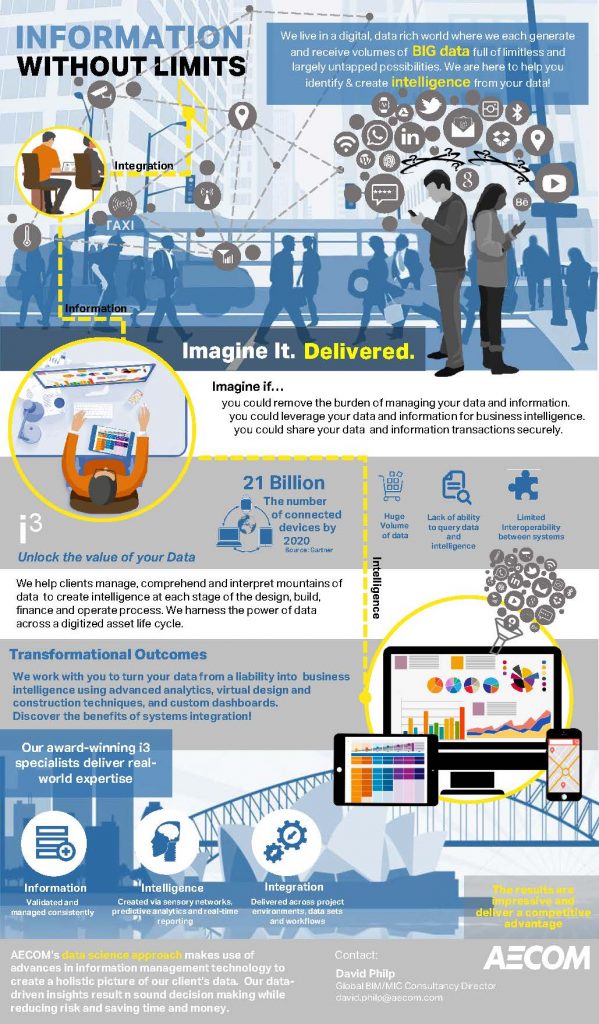Big Data can help building owners and operators leverage insight from a wide range of sources to optimise their assets – and their businesses. Jon Anunson of i3 by AECOM says BIM can be an excellent starting point to get information flowing
Why does the topic of Big Data keep coming up in reference to building information models (BIM)? Is a Revit model Big Data? Technically, it’s not Big Data on its own – even though it could represent millions of data points and gigabytes of information – particularly when we measure Big Data on variety, velocity and volume. It’s worth mentioning here that many smaller AEC organisations do encounter the Big Data challenge of BIM in that their traditional technologies and techniques are struggling to process it.
BIM are rarely big data on their own, but they certainly do play a key role in producing Big Data. We’re not just talking Revit or other BIM files within traditional workflows, but construction information, product information, purchase orders, warranties, contracts, subcontracts, contacts, schedules, budgets, etc. These all tie fairly neatly into the coordinates of a BIM, but extend into the kind of variety that stymies our current tools fairly regularly. In larger projects, we may start to approach the velocity of Big Data if we broaden our consumption to include the entire design and construction process: issues, resolutions, transmittals, change orders and other interactions that concern parts or areas of the model. Big Data tools and techniques begin to become effective when we include this information, especially in aggregate.
Another key to understanding Big Data is remembering that as AEC contractors and designers, it’s not our data that will be big – it’s our clients’ data. We’re designing infrastructure that will become the source of Big Data as it operates. What we can create, through well-formulated BIM and construction data, is a scaffold or framework where we can attach the many streams of data and telemetry that will be generated by that infrastructure or portfolio of assets. Streams of data that could come from infrastructure include occupancy and electronic lock/security access, sensor data, telemetry from systems within buildings, or even sensor data from roads and bridges.
When we have an intelligent framework to reference this data against, it’s already more usable and more informative. The BIM provides not only a spatial organisation system to visually understand input, but also a semiotic framework that can align with other qualifications of the data, such as importance or which operations group may be interested in knowing about status changes. What we reach with this combination of telemetry and semiotic framework is the intersection of BIM and the IoT. When properly organised and instrumented, we can assist clients in opening the floodgates for opportunities to optimise their assets.
At AECOM, we see the value of data continuity because we work across the asset lifecycle. David Philp, global BIM/MIC consultancy director, developed our i³ by AECOM services to help clients achieve the benefits of their data after construction. In a project with frictionless data, operators of a building can ‘continuously commission’ systems, comparing real-time telemetry to the simulated design performance to optimise efficiency and predict maintenance issues. Once a built asset is in operation, a growing percentage of our built infrastructure begins to generate its own data, beyond the feeds from sensors, motors and controls. Even concrete can provide data through sensors, such as curing conditions, stresses, and vibrations. In an Asset Information Model, BIM may interface and exchange data with existing enterprise systems such as SCADA and ERP. When your infrastructure and operations, right down to the concrete and financials, begin to generate data, you definitely enter the realm of Big Data.
The BIM framework when amplified as outlined previously and tied to organisational data, such as sales, utility costs, supply chain, profitability, productivity, customer satisfaction, throughput or other operational KPIs, can become the basis of a powerful information model that can help our clients not only optimise their assets, but also their businesses!
We’ve found a growing market of clients that are eager to instrument their assets to improve their business, and have begun to offer services to help make this last connection in the asset information lifecycle. Imagine campuses that can predict trash pick-up needs, retail chains that can optimise layouts for sales and predict demand for fresh goods hours or days sooner than currently. All of the data is there! It’s big, and often messy, but the dormant power is simply waiting to be translated into transformational intelligence for our clients.
Big Data and analytics are a top business priority for most leading AEC firms and drive enormous opportunity for business improvement, decision making and insight. BIM data may not always qualify as BIG by itself, but it’s certainly a great place to start the classification of data. Whether it becomes big through continuity or big through aggregation, there are fascinating opportunities for design professionals as we recognise ourselves as originators of Big Data streams! BIM isn’t the centre of the universe – it is, however, a key player.
An architect and database designer, Jon Anunson has been working with rich 3D data for over 25 years. As Global Manager of Process and Metrics, Jon designs systems (or tools) and programs (or behaviour) that help AECOM deliver design, construction, finance and operations services worldwide, while measuring what we do.
 Jon Anunson
Jon Anunson
Senior Manager, Process & Metrics,
Project Technologies, Global
i3 by AECOM
Twitter: @AECOM
Twitter: @janunson














